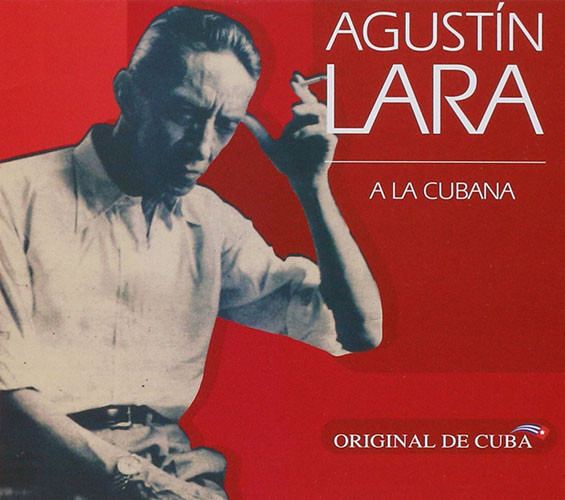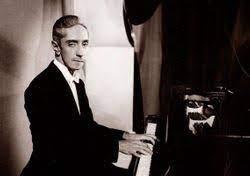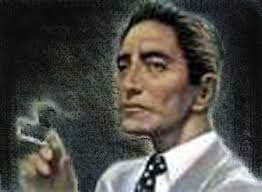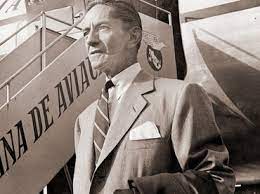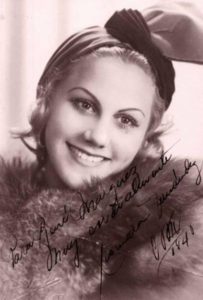AGUSTÍN LARA “EL FLACO DE ORO”, SU AMOR Y CARRERA ARTÍSTICA EN CUBA. VIDEOS. PHOTOS
Ángel Agustín María Carlos Fausto Mariano Alfonso del Sagrado Corazón de Jesús Lara y Aguirre del Pino; conocido como Agustín Lara, fue un compositor e intérprete mexicano de canciones y boleros nacido el 30 de octubre de 1897 y reconocido como uno de los compositores más populares de su época. Muchas veces hizo declaraciones durante su carrera poniendo de relieve tu admiración y su amor por Cuba.
Se ha comentado en los medios de la farándula popular de Cuba y otros países que en los inicios de su carrera el gran compositor habanero René Touzet, allá en la década de 1930, al proponerles sus composiciones a trovadores de la época, como Codina y Guyún, para que se las cantaran, le apenaba decir que eran de su autoría y se las atribuía a search Agustín Lara… y eran tan buenas que todos lo daban por cierto.
La vida intima de Agustin Lara, pródiga en romances, acrecentó el mito de carne y hueso que fue este hombre. Su gran amor fue, y así lo confesó el compositor, la bellísima y siempre controvertida actriz María Félix, con la que contrajo matrimonio en 1945 y a la que dedicó melodías como María bonita, Palmeras y Noche de ronda, una relación que a la postre se disolvió en el fracaso por los devaneos amorosos que se atribuyeron a la Doña. Pero mujeres hubo muchas en la vida de search Agustín Lara, desde la Chata Zozaya, su primera esposa, hasta aquella que enloquecida por los celos le tajó con una navaja el lado izquierdo de la cara para dejarle una cicatriz que no podría disimular durante el resto de su vida. Como dice el escritor Juan José Arreola, Lara fue un castigador y un castigado.
VIDEOS- AGUSTIN LARA INTERPRETA AL PIANO…
CARRERA ARTÍSTICA Y AMOROSA DE AGUSTÍN LARA EN CUBA
Corre el año 1932 y search Agustín Lara emprende una carrera frenética hacia la fama. Hace en esa fecha su primera gira internacional. En París arrebata a los franceses y una de sus composiciones, Farolito, se convierte allí en la melodía de moda.
Es por ese tiempo que hace su primer viaje a la capital cubana, en la compañía de Pedro Vargas y Ana María Fernández. Vuelve en mayo de 1939. Hace entonces una profesión de amor a Cuba. Declara entonces: «Regresaba de Francia… La Habana me abrió sus brazos… y no fui ingrato, ahí están ese Sueño guajiro y esas Coplas que nacieron en la inmensa pradera del Yumurí…». Está aquí nuevamente en 1952. En La Bodeguita del Medio conoce a Sindo Garay y en el cabaret Montmartre toca el piano y conduce una orquesta de violines. Actúa en los Aires Libres del hotel Saratoga. Afirma el erudito Radamés Giro: «De su interés por la música cubana dan cuenta La Cumbancha —homenaje a la percusión cubana que grabó el Trío Matamoros, Antonio Machín y el cuarteto Caney—, Noche criolla y el danzonete Pobre de mí».
Es en la visita de 1939 cuando lo impacta una muchacha que se había revelado como Estrella naciente en La Corte Suprema del Arte, del Circuito CMQ, y que en esos momentos hacía un poco de todo en la propia emisora: hace la locución, canta y recita en la emisora de Monte y Cárdenas. Se llama Xiomara Fernández; tiene 21 años de edad y es tan bella como tímida. Gaspar Pumarejo, que sería el pionero de la TV en Cuba, los presenta. No han cambiado más que unas pocas palabras cuando Lara expresa su deseo de escribir una canción para que ella la estrene. Xiomara no sabe qué responder, queda sin palabras. Se siente pequeñita ante un compositor de la talla del que tiene delante, pero al fin, con muchas dudas, accede. Lara escribe para ella Cuando me miraste tú, que Xiomara estrena en el Gran Teatro de La Habana, acompañada al piano por el propio compositor. La cantaría luego en teatros de Matanzas y Pinar del Río.
«Toda la gloria fue mía /cuando me miraste tú / toda la gloria fue mía /cuando me miraste tú / se quedó sin luz el día / todo se quedó sin luz /y empezó la vida mía / cuando me miraste tú…» compuso Lara entonces.
Xiomara Fernández recordaría muchos años después que siempre se sintió fascinada por Agustín; era muy fino y delicado, decía. Le enviaba todos los días un ramo de flores a la CMQ. Ella temió que tanta gentileza llamara la atención y despertara sospechas entre sus compañeros y se lo hizo saber. Él entonces comenzó a enviarle a diario una sola flor con una tarjeta en la que se leía: «Pensando en ti».
Se encontraron varias veces en uno de los bares del hotel Sevilla. Lara le habló de llevarla a México en planes de trabajo, y precisó que podía ir en compañía de algún familiar. A Xiomara el viaje no le interesaba. Lara se tiró a fondo entonces y le propuso matrimonio. Ella dijo no.
Prosiguió Xiomara una carrera ascendente y no demoró en iniciar un noviazgo con José Antonio Alonso, el disputado conductor de La Corte Suprema, el hombre de las mil novias, como le llamaba la prensa de la época. La boda fue todo un acontecimiento. Contrajeron matrimonio el 1ro. de diciembre de 1940, en el Gran Teatro de La Habana, con la sala repleta de radioyentes y gente de la farándula. Para ver y aclamar a la pareja esperaban fuera cientos de admiradores, entre ellos un piloto que hizo aterrizar su avioneta en el Paseo del Prado, frente al Teatro, para soltar palomas y entregar un ramo de flores a la desposada.
DE CUBA EN HONOR A LARA
La música de search Agustín Lara se mantiene en el repertorio de cantantes cubanos de todas las épocas, dentro y fuera de la Isla.
El disco ‘Solamente una vez’ de Cuba a Lara recoge las interpretaciones de grandes voces que lo cantan a la cubana. Pablo Milanés interpreta Noche de ronda, y Omara Portuondo, Solamente una vez, mientras que la Orquesta Aragón acomete Lamento jorocho, y Francisco Céspedes vocaliza Regalo de viaje, por petición expresa de una de las exesposas del compositor. Están también en la placa Van Van, Miriam Ramos, Kelvis Ochoa, Carlos Varela, Santiago Feliú y David Torrens, entre otros.
«Lara ha sido parte de sus vidas, algunos crecieron con él y todos lo han adoptado como si fuera cubano», afirmó el productor mexicano de este disco.
En su momento fueron muy celebradas las interpretaciones, que, por separado, hicieron de Arráncame la vida, Orlando Contreras y Abelardo Barroso, que cantaba mejor a medida que envejecía. Memorables son las de Pecado, de Blanca Rosa Gil, y la que hizo Barbarito Diez de Palmeras. Mucho gustan El organillero, por la Aragón, Rival, por la orquesta América y Amor de mis amores, por Elena Burke. Se mantiene viva en el recuerdo la interpretación que Roberto Sánchez y la orquesta Gloria Matancera hicieron de Santa, la melodía que Lara prefería entre todas las que compuso.
Sus melodías se relacionaron de alguna manera con esa Habana que aplaudió su arte en la CMQ, en los Aires Libres del Hotel Saratoga , en el cabaret Montmatre.
La música del gran amor de María Félix y de otras muchas mujeres hermosas, fue interpretada en todos los géneros cubanos por nuestros más populares artistas: Antonio Machín, Barbarito Diez, Abelardo Barroso, René Cabell, Tito Gómez, Olga Chorens, Dámaso Pérez Prado, Benny Moré, Elena Bourque, Omara Portuondo.
Sus melodías sonaban en todas las victrolas de la Isla, que, por cierto, solamente en La Habana pasaban de 10 mil en 1954.
Agustín Lara: un mito de carne y hueso. De él es esta frase: “Aquí estoy de nuevo en Cubita la bella. Vengo dispuesto a lo que sea”.
Agustin Lara, el Flaco de oro, tiene su monumento en la Avenida del Puerto, a la orilla de la bahía habanera. Una estatua de bronce, obra del escultor yucateco Humberto Peraza, que evoca la presencia del compositor entre nosotros. Resalta la imagen la extrema delgadez del artista que viste de corbata y chaqueta. Su mano izquierda descansa en el brazo derecho mientras la diestra se alza a la altura de la cara para insinuar la presencia del cigarrillo que se llevará a la boca. Y es que el autor de la opereta El pájaro de oro y de tanta música para el cine, fumador incesante en vida, fuma ahora en la eternidad.
AGUSTÍN LARA, “EL FLACO DE ORO”, HIS LOVE AND ARTISTIC CAREER IN CUBA.VIDEOS. PHOTOS
Ángel Agustín María Carlos Fausto Mariano Alfonso of the Sacred Heart of Jesus Lara and Aguirre del Pino; known as Agustín Lara, he was a Mexican composer and interpreter of songs and boleros born on October 30, 1897 and recognized as one of the most popular composers of his time. Many times he made statements during his career highlighting his admiration and his love for Cuba.
It has been commented in the media of popular entertainment in Cuba and other countries that at the beginning of his career the great Havana composer René Touzet, back in the 1930s, when he proposed his compositions to troubadours of the time, such as Codina and Guyún, to be sung, he was ashamed to say that they were his authorship and he attributed them to Agustín Lara… and they were so good that everyone took it for granted.
The intimate life of Agustin Lara, prodigal in romances, increased the myth of flesh and blood that this man was. His great love was, and so the composer confessed, the beautiful and always controversial actress María Félix, whom he married in 1945 and to whom he dedicated melodies such as María bonita, Palmeras and Noche de ronda, a relationship that ultimately dissolved in failure due to the love affairs that were attributed to the Doña. But there were many women in the life of Agustín Lara, from Chata Zozaya, his first wife, to the one who, maddened by jealousy, cut the left side of his face with a knife to leave a scar that he would not be able to hide for the rest of his life. As the writer Juan José Arreola says, Lara was a punisher and a punished person.
ARTISTIC AND LOVE CAREER OF AGUSTÍN LARA IN CUBA
The year is 1932 and Agustín Lara embarks on a frantic race towards fame. He makes his first international tour on that date. In Paris he captivates the French and one of his compositions, Farolito, becomes the fashionable melody there.
It is around this time that he made his first trip to the Cuban capital, in the company of Pedro Vargas and Ana María Fernández. He returns in May 1939. He then makes a profession of love for Cuba. He then declared: «I was returning from France… Havana opened its arms to me… and I was not ungrateful, there are that Sueño guajiro and those Songs that were born in the immense Yumurí prairie…». He is here again in 1952. At La Bodeguita del Medio he meets Sindo Garay and at the Montmartre cabaret he plays the piano and conducts a violin orchestra. He performs in the Aires Libres at the Saratoga hotel. The scholar Radamés Giro affirms: «His interest in Cuban music is evidenced by La Cumbancha —a tribute to the Cuban percussion recorded by the Trío Matamoros, Antonio Machín and the Caney quartet—, Noche criolla and the danzonete Pobre de mí».
It is during his visit in 1939 when he was struck by a girl who had revealed herself as a rising star in the Supreme Court of Art, of the CMQ Circuit, and who at that time was doing a little of everything at the station itself: she did the locution, sings and recites at the Monte y Cárdenas station. Her name is Xiomara Fernández; she is 21 years old and is as beautiful as she is shy. Gaspar Pumarejo, who would be the pioneer of TV in Cuba, introduces them. They haven’t exchanged more than a few words when Lara expresses her desire to write a song for her to premiere. Xiomara doesn’t know what to answer, she is speechless. She feels tiny before a composer of the stature that she has in front of her, but in the end, with many doubts, she agrees. Lara writes for her Cuando me miraste tú, which Xiomara premieres at the Gran Teatro de La Habana, accompanied on piano by the composer himself. He would later sing it in theaters in Matanzas and Pinar del Río.
«All the glory was mine / when you looked at me / all the glory was mine / when you looked at me / the day ran out of light / everything ran out of light / and my life began / when you looked at me…» Lara composed then.
Xiomara Fernández would remember many years later that she always felt fascinated by Agustín; he was very fine and delicate, she said. She sent a bouquet of flowers to the CMQ every day. She was afraid that such kindness would draw her attention and she would arouse suspicion among her classmates and she let him know. He then began to send her a single flower every day with a card that read: “Thinking of you.”
They met several times in one of the bars of the Sevilla hotel. Lara spoke to her about taking her to Mexico for work plans, and she specified that she could go in the company of a relative. Xiomara was not interested in the trip. Lara threw herself to the bottom then and proposed to her. She said no.
Xiomara continued an ascending career and it did not take long to start an engagement with José Antonio Alonso, the disputed conductor of the Supreme Court, the man of a thousand girlfriends, as the press of the time called him. The wedding was quite an event. They got married on the 1st. December 1940, at the Gran Teatro de La Habana, with the hall full of radio listeners and show business people. Hundreds of admirers waited outside to see and acclaim the couple, including a pilot who landed his plane on the Paseo del Prado, in front of the Theater, to release doves and deliver a bouquet of flowers to the bride.
FROM CUBA IN HONOR OF LARA
The music of search Agustín Lara remains in the repertoire of Cuban singers of all times, inside and outside the Island.
The album ‘Solamente una vez’ by Cuba a Lara includes the interpretations of great voices that sing it Cuban-style. Pablo Milanés performs Noche de ronda, and Omara Portuondo, Solamamente una vez, while the Orquesta Aragón undertakes Lamento jorocho, and Francisco Céspedes vocalizes Regalo de viaje, at the express request of one of the composer’s ex-wives. Also on the plaque are Van Van, Miriam Ramos, Kelvis Ochoa, Carlos Varela, Santiago Feliú and David Torrens, among others.
“Lara has been part of his life, some grew up with him and everyone has adopted him as if he were Cuban,” said the Mexican producer of this album.
At the time, the interpretations of Arráncame la vida by Orlando Contreras and Abelardo Barroso, who sang better as he got older, were very celebrated. Those of Pecado, by Blanca Rosa Gil, and the one made by Barbarito Diez de Palmeras are memorable. They really like El organillero, by Aragón, Rival, by the América orchestra and Amor de mis amores, by Elena Burke. The interpretation that Roberto Sánchez and the Gloria Matancera orchestra made of Santa remains alive in the memory, the melody that Lara preferred among all those that he composed.
His melodies were somehow related to that Havana that applauded his art at the CMQ, at the Aires Libres of the Saratoga Hotel, at the Montmatre cabaret.
The music of the great love of María Félix and many other beautiful women was interpreted in all Cuban genres by our most popular artists: Antonio Machín, Barbarito Diez, Abelardo Barroso, René Cabell, Tito Gómez, Olga Chorens, Dámaso Pérez Prado, Benny Moré, Elena Bourque, Omara Portuondo.
His melodies played on all the jukeboxes on the island, which, by the way, in Havana alone exceeded 10,000 in 1954.
Agustín Lara: a myth of flesh and blood. This sentence is from him: “Here I am again in Cubita la bella. I come ready for whatever.”
Agustin Lara, the Golden Skinny, has his monument on Avenida del Puerto, on the shore of the Havana bay. A bronze statue, the work of the Yucatecan sculptor Humberto Peraza, which evokes the presence of the composer among us. The image highlights the extreme thinness of the artist who wears a tie and jacket. His left hand rests on his right arm while his right hand is raised to the level of his face to hint at the presence of the cigarette that he will take to his mouth. And it is that the author of the operetta The Golden Bird and of so much music for the cinema, an incessant smoker in life, smokes now in eternity.
Agencies/ Wiki/ Ciro Bianchi/ RadioHabana/ AgustinLaraBio./ Extractos/ Excerpts/ Internet Photos/ YouTube/ Arnoldo Varona/ www.TheCubanHistory.com
THE CUBAN HISTORY, HOLLYWOOD.



